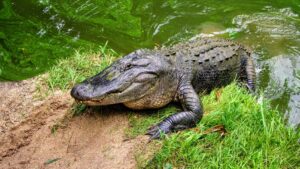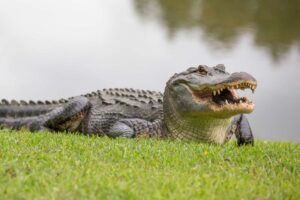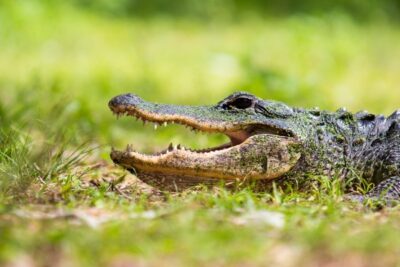In the heart of the mysterious swamps and waterways that alligators call home, a question often arises among curious minds: Do alligators shed their skin? These formidable reptiles, with their armored bodies and prehistoric allure, have long fascinated both scientists and nature enthusiasts alike.
To delve into the intricacies of this enigma, we embark on a journey to uncover the secrets hidden beneath the murky waters and explore the fascinating phenomenon of alligator skin shedding. Join us as we peel back the layers of this captivating reptilian mystery, examining the science behind it and gaining insights into the unique lifecycle of these ancient creatures.
Do alligators shed their skin?

Alligator Anatomy and Skin Composition
Alligators are reptiles with unique anatomical features that are adapted to their semi-aquatic lifestyle. Here are some key aspects of alligator anatomy and skin composition:
- Scales: Alligators have tough, bony plates on their backs known as scutes. These scutes are actually modified scales that provide protection and help regulate the alligator’s body temperature. The skin on their belly is smoother and lacks the bony scutes.
- Dermis and Epidermis: The skin of an alligator consists of two main layers—the epidermis and the dermis. The epidermis is the outermost layer, while the dermis lies beneath it.
- Scale Arrangement: The scales on an alligator’s body are not uniform in size. The larger, more prominent scales are found on the back, providing a protective armor. The arrangement of scales can vary slightly between species of alligators.
- Coloration: Alligators typically have dark, olive-green to black coloration, which helps them blend into their natural habitats. The coloration also provides some protection against UV radiation.
- Osteoderms: The bony scutes on an alligator’s back, known as osteoderms, are embedded in the dermis. These osteoderms provide additional protection and structural support.
- Glands: Alligator skin contains specialized glands that secrete oils. These oils help keep the skin hydrated, provide some waterproofing, and may have antimicrobial properties.
- Molting: As mentioned earlier, alligators shed their skin throughout their lives. This process is continuous and helps in growth, regeneration, and the removal of parasites and debris.
- Sensory Organs: Alligators have sensory organs called integumentary sense organs (ISOs) scattered on their skin. These organs are sensitive to pressure and vibrations in the water, assisting them in detecting prey and potential threats.
Overall, the unique skin composition of alligators contributes to their ability to thrive in aquatic environments and adapt to a variety of conditions. Their tough scales and other adaptations help protect them from physical damage and contribute to their success as predators.
Structure and characteristics of alligator skin
Alligator skin is known for its distinctive characteristics and unique structure, making it valuable in various industries, particularly in the production of luxury goods such as bags, shoes, and accessories.
Here are some key features of alligator skin:
- Scales:
- Alligator skin is covered in bony plates called scutes. These scutes are arranged in rows and are more pronounced on the back, providing a protective layer.
- The size and pattern of the scales can vary between different species of alligators.
- Texture:
- Alligator skin has a distinct texture that is characterized by the arrangement of the scales. The scales are typically raised and have a bumpy or ridged appearance.
- Coloration:
- The natural color of alligator skin can vary, but it is generally dark, ranging from olive-green to black. The coloration helps alligators blend into their swampy and murky habitats.
- The skin can be dyed for various fashion purposes, allowing for a range of colors in finished products.
- Flexibility:
- Despite the toughness of the scales, alligator skin is relatively flexible. This flexibility makes it suitable for crafting into various products, including bags and shoes.
- Durability:
- Alligator skin is known for its durability and resistance to wear and tear. The tough scales provide a level of protection against scratches and abrasions.
- Pores and Glands:
- Alligator skin contains pores and glands that secrete oils. These oils contribute to the skin’s natural sheen, help keep it supple, and offer some waterproofing.
- Cross-Hatch Pattern:
- When examined closely, the skin often exhibits a distinctive cross-hatch pattern between the scales. This pattern is a result of the way the scales overlap and is a characteristic feature of alligator skin.
- Uniformity:
- While the scales on the back are larger and more prominent, the skin on the belly is generally smoother and lacks the bony scutes. The belly skin is often used in luxury goods due to its smoother texture.
- Crafting Process:
- Alligator skin undergoes a tanning and finishing process during the production of goods. Tanning helps preserve the skin and enhances its features, while finishing processes may include polishing, coloring, and other treatments to achieve the desired appearance.
Due to its unique characteristics and aesthetic appeal, alligator skin is highly sought after in the fashion industry. However, it’s important to note that regulations and ethical considerations surround the use of alligator skin, and sustainable practices are encouraged to ensure the conservation of these reptiles.
Role of scales in protecting alligators
Alligators have evolved over millions of years and have developed various adaptations to thrive in their environments. One crucial adaptation is their scaly skin, which serves multiple functions in protecting them.
Here are some roles of scales in protecting alligators:
- Armor-like Protection:
- Alligator scales act as a form of armor, providing a tough and durable outer layer that helps protect them from physical injuries and attacks. The scales are made of keratin, the same protein found in human fingernails and hair, but they are structured in a way that enhances their toughness.
- Camouflage:
- The coloration and pattern of alligator scales help them blend into their surroundings, providing effective camouflage. This makes it easier for alligators to ambush prey and avoid predators. Young alligators often have more vivid markings to mimic the dappled sunlight and shadows in their habitat.
- Thermoregulation:
- Alligator scales play a role in thermoregulation by helping to control the animal’s body temperature. The dark coloration of their scales absorbs sunlight, aiding in warming their bodies. On the other hand, lighter-colored scales help reflect sunlight, preventing overheating.
- Waterproofing:
- The scales on an alligator’s skin help in retaining moisture and preventing water loss. This is particularly important for alligators that inhabit aquatic environments. The waterproofing properties of the scales contribute to the alligator’s ability to move between aquatic and terrestrial environments.
- Hygiene and Disease Prevention:
- Alligator scales are thought to inhibit the growth of certain bacteria and fungi. This may help protect them from infections and diseases that could arise from exposure to various microorganisms present in their environments.
- Sensory Function:
- Scales also contain sensory organs, such as integumentary sense organs (ISOs), which are sensitive to pressure and vibration. These sensory structures contribute to the alligator’s ability to detect movement and disturbances in the water, aiding in hunting and avoiding potential threats.
While scales provide a level of protection, alligators, like any species, are not immune to threats such as habitat loss, pollution, and human-wildlife conflict. Conservation efforts are crucial to ensuring the long-term survival of alligator populations and their ecosystems.
Shedding in Alligators

Shedding in alligators, as in many reptiles, is a natural process that involves the renewal of their skin, including the outer layer of scales. This shedding process is called molting or ecdysis.
Here are the key aspects of shedding in alligators:
- Frequency:
- Alligators undergo shedding periodically throughout their lives. The frequency of shedding varies with age, growth rate, and environmental factors. Younger alligators tend to shed more frequently than older individuals.
- Growth and Renewal:
- The shedding process is closely linked to the growth of the alligator. As the alligator grows, its skin becomes stretched, and the outer layer of scales may become worn or damaged. Molting allows the alligator to replace the old, worn-out skin with a new layer of scales, accommodating its increasing size.
- Triggering Factors:
- Several factors can trigger the shedding process in alligators. Environmental conditions such as temperature, humidity, and daylight hours may play a role. Hormonal changes and the need for the alligator to repair and renew its skin are also factors that contribute to the initiation of shedding.
- Process:
- The shedding process typically begins with the alligator’s skin becoming dull and opaque. This is followed by the formation of a new layer of skin beneath the old one. The alligator then starts to rub its body against objects, such as rocks or vegetation, to help loosen and remove the old skin. The shedding process can take a few days to complete.
- Ecdysis and Behavior:
- During ecdysis, alligators may exhibit changes in behavior. They may become more reclusive or spend more time in the water, which can help facilitate the shedding process. The rubbing of the body against surfaces assists in loosening the old skin, and alligators may also use their jaws to grasp and peel away sections of the shedding skin.
- Feeding Behavior:
- Alligators may reduce their feeding activity during the shedding process. This is thought to be associated with the fact that the outer layer of scales around the jaws and eyes is shed, and during this time, the alligator’s vision and ability to capture prey may be temporarily impaired.
It’s important that shedding is a natural and necessary part of the life cycle for reptiles, including alligators. This process helps them maintain healthy and functional skin, ensuring their overall well-being in their habitats.
Frequency and patterns of shedding in alligators
Environmental factors influencing alligator shedding
Alligators undergo a shedding process called molting, during which they shed their old skin and grow new skin. This process is influenced by various environmental factors.
Here are some of the key environmental factors that can affect alligator shedding:
- Temperature:
- Alligators are ectothermic, meaning their body temperature is influenced by the external environment. Warmer temperatures generally accelerate metabolic processes, including skin shedding. Higher temperatures can promote more frequent and efficient molting.
- Humidity:
- Humidity levels can impact the ease with which an alligator can shed its skin. High humidity helps soften the old skin, making it easier for the alligator to slough it off.
- Water Quality:
- The quality of the water in which alligators live can affect their skin condition. Clean water with appropriate pH levels and minimal pollutants can contribute to healthy skin and facilitate the shedding process.
- Water Temperature:
- The temperature of the water plays a role in the overall health of alligators. Warm water can stimulate blood flow and metabolism, facilitating the shedding process.
- Seasonal Changes:
- Alligators may exhibit seasonal variations in their shedding patterns. For example, in colder climates, alligators may be less active during the winter months, and shedding may occur less frequently.
- Diet and Nutrition:
- The availability and quality of food resources can impact an alligator’s overall health and, subsequently, its ability to shed its skin. Proper nutrition is essential for maintaining a healthy skin structure.
- Habitat Conditions:
- The overall condition of the alligator’s habitat, including the presence of suitable basking areas and shelter, can influence the shedding process. Access to appropriate environments for basking is crucial for promoting shedding.
- Stress Levels:
- Alligators may experience stress in response to various factors, such as disturbances by humans or changes in their habitat. Elevated stress levels can potentially affect the frequency and efficiency of shedding.
- Photoperiod (Day Length):
- Day length, or photoperiod, can influence the hormonal regulation of molting in reptiles. Changes in daylight duration can trigger physiological responses that impact the shedding cycle.
- Age and Health of the Alligator:
- Younger and healthier alligators may shed more frequently than older or less healthy individuals. The overall vitality of the alligator plays a role in its ability to undergo successful molting.
Understanding and managing these environmental factors is important for the conservation and well-being of alligator populations in captivity and in the wild. Changes in any of these factors can potentially impact the shedding behavior of alligators.
Importance of Shedding for Alligators

Shedding, or molting, is a crucial physiological process for alligators and other reptiles. It serves several important functions for their health and overall well-being.
Here are some key reasons why shedding is important for alligators:
- Regeneration of Skin:
- Shedding allows alligators to replace old, damaged, or worn-out skin with new, healthy skin. This is essential for maintaining the integrity of their skin as a protective barrier against the environment.
- Growth:
- Molting is closely tied to the growth of alligators. As alligators grow, their skin becomes stretched and may no longer fit properly. Shedding allows them to accommodate their increasing size and replace the skin that has become too small.
- Removal of Parasites and Pathogens:
- Shedding helps remove external parasites, such as mites and ticks, as well as pathogens that may be present on the skin. This process contributes to the overall hygiene and health of the alligator.
- Improved Skin Function:
- The shedding process helps maintain the functionality of the skin. A healthy and regularly shed skin allows for optimal thermoregulation, respiration, and sensory perception. It also aids in the efficient exchange of gases and nutrients through the skin.
- Coloration and Camouflage:
- Alligators often exhibit vibrant coloration on their skin. Shedding allows them to maintain the brilliance of their colors, which can play a role in communication, courtship displays, and camouflage in their natural environment.
- Behavioral Changes:
- Molting can be associated with changes in behavior. During the shedding process, alligators may become more subdued, spend more time in the water, and exhibit reduced activity. These behavioral changes are part of the natural cycle of molting.
- Prevention of Infections:
- Regular shedding helps prevent skin infections. If old skin remains attached for too long, it can create a favorable environment for bacterial or fungal growth. Shedding removes this potential source of infection.
- Hormonal Regulation:
- The shedding process is influenced by hormonal changes in the alligator’s body. These hormonal fluctuations are not only essential for triggering molting but also play a role in other physiological processes, such as reproduction and metabolism.
- Maintenance of Health and Vitality:
- Overall, shedding contributes to the general health and vitality of alligators. A healthy skin condition is indicative of a well-functioning immune system and proper metabolic processes.
Understanding the importance of shedding is crucial for the proper care and management of alligators in captivity and in their natural habitats. Conservation efforts often take into consideration the factors that promote natural behaviors, including the molting cycle, to ensure the well-being and sustainability of alligator populations.
Growth and regeneration of skin in alligators
Conclusion
This page answers the question on do alligators shed their skin. The shedding process, known as molting, is a natural and vital aspect of an alligator’s life cycle. It serves various purposes, including the regeneration of new, healthy skin, accommodating growth, removing parasites, and maintaining overall skin functionality.
Also, molting is a cyclical and essential process that contributes to the well-being and vitality of alligators in both captive and wild environments.

